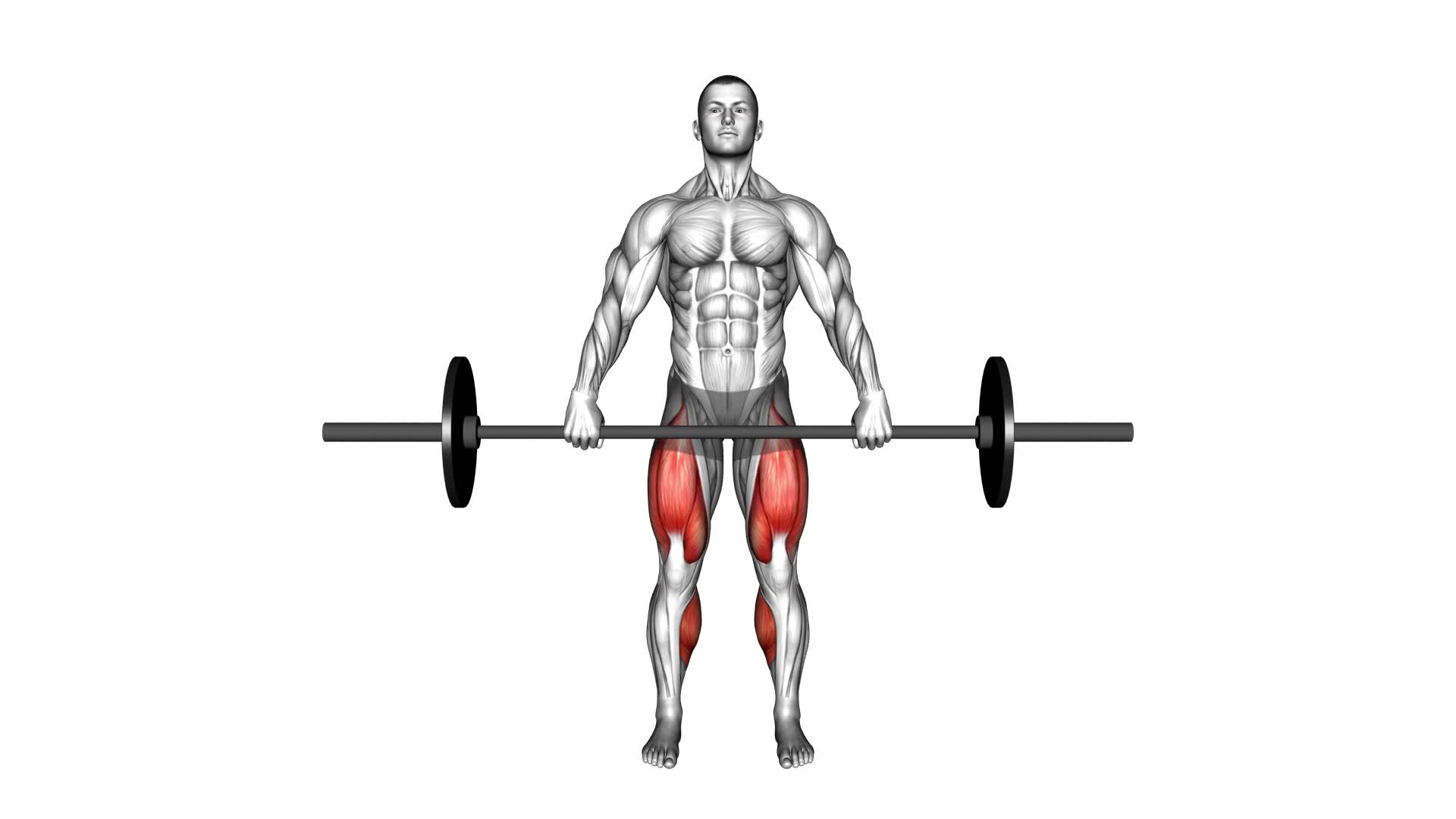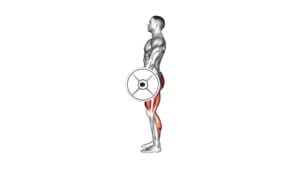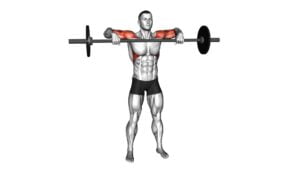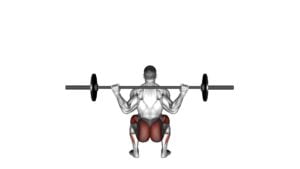Barbell Deadlift (front POV) (male) – Video Exercise Guide & Tips

Get ready to level up your workout with the barbell deadlift!
Watch This Exercise Video
In this video exercise guide, we'll show you step-by-step how to perform this powerful move from a front point of view.
Perfect your technique and boost your strength with our expert tips.
Whether you're a seasoned lifter or just starting out, this guide is for you.
So grab your barbell and get ready to crush your deadlifts like a pro!
Key Takeaways
- Barbell deadlifts can significantly increase muscle mass.
- Barbell deadlifts target multiple muscle groups such as glutes, hamstrings, quadriceps, and lower back.
- There are various variations of barbell deadlifts to suit different goals and preferences.
- Barbell deadlifts improve functional strength, athleticism, reduce the risk of injury, and enhance overall physical performance.
Benefits of Barbell Deadlifts
You will experience numerous benefits from incorporating barbell deadlifts into your workout routine. One of the main advantages is the significant increase in muscle mass that this exercise provides. Deadlifts target multiple muscle groups, including the glutes, hamstrings, quadriceps, and lower back. By engaging these large muscle groups, you can promote overall strength and build lean muscle mass.
In addition to increasing muscle mass, barbell deadlifts offer a variety of variations that can further enhance your workout routine. Some common variations include sumo deadlifts, Romanian deadlifts, and trap bar deadlifts. These variations target specific muscle groups or provide different levels of intensity, allowing you to tailor your workout to your specific goals and preferences.
Furthermore, incorporating barbell deadlifts into your routine can also improve your functional strength and overall athleticism. This exercise mimics movements used in daily activities, such as lifting heavy objects or picking up groceries. By regularly performing deadlifts, you can develop the strength and stability needed for these activities, reducing the risk of injury and improving your overall physical performance.
Proper Set Up and Grip
To ensure proper form and maximize your performance, it's essential to consistently and accurately set up and grip the barbell for the deadlift exercise.
Proper set up and grip are crucial for maintaining control and preventing injuries.
When setting up for the barbell deadlift, start by standing with your feet shoulder-width apart, and the barbell centered over your mid-foot. Bend at your hips and knees to lower yourself down, maintaining a neutral spine.
Grip the barbell with your hands slightly wider than shoulder-width apart, using an overhand grip. This grip is suitable for most individuals and allows for a secure hold on the barbell.
However, if you find it difficult to maintain your grip, you can try using alternative grip options. One alternative grip is the mixed grip, where one hand is in an overhand position and the other in an underhand position. This grip helps to increase grip strength and prevent the barbell from slipping out of your hands.
Another alternative grip option is the hook grip, where you wrap your fingers over your thumb instead of wrapping your thumb around the barbell. This grip can be uncomfortable at first but provides a secure grip on the barbell.
Experiment with different grip options to find what works best for you.
Executing the Barbell Deadlift
Once you have properly set up and established a secure grip on the barbell, it's important to execute the barbell deadlift with consistent form and control. The barbell deadlift is a compound exercise that primarily targets your glutes, hamstrings, and lower back muscles.
To perform the movement, start by standing with your feet shoulder-width apart, toes slightly pointing outwards. Bend at your hips and knees, keeping your back straight and your chest up. Grab the barbell with an overhand grip, hands slightly wider than shoulder-width apart.
Engage your core and drive through your heels as you lift the barbell off the ground, extending your hips and knees simultaneously. Keep the barbell close to your body throughout the movement to maintain proper form. Once you reach a standing position, slowly lower the barbell back down to the ground by bending at your hips and knees.
To add variety to your workouts and challenge your muscles in different ways, you can incorporate different variations of the barbell deadlift. Some popular variations include the sumo deadlift, which involves a wider stance and a grip inside your legs, and the Romanian deadlift, which focuses more on the hamstrings and requires a slight knee bend while keeping the back straight.
When incorporating deadlifts into your workout routine, it's important to start with a weight that allows you to maintain proper form and gradually increase the weight as you become more comfortable and stronger. Remember to always warm up before performing any exercise and consult with a fitness professional if you have any concerns or questions.
Common Mistakes to Avoid
When executing the barbell deadlift, it's crucial to be aware of common mistakes that can hinder your form and potentially lead to injury. By avoiding these mistakes, you can improve your technique and reduce the risk of hurting yourself during this exercise.
One common mistake to watch out for is rounding your back. It's important to keep your back straight throughout the movement to avoid straining your spine. Engage your core and maintain a neutral spine position to protect your back.
Another mistake to avoid is using your arms to lift the weight. The barbell deadlift is primarily a lower body exercise, and using your arms too much can put unnecessary strain on your upper body. Instead, focus on using your legs and hips to drive the movement and lift the weight.
Improper foot placement is another common mistake that can lead to injury. Make sure your feet are shoulder-width apart and that your weight is evenly distributed through your heels. This will help you maintain balance and stability throughout the exercise.
Lastly, avoid jerking or using excessive momentum when lifting the weight. This can put undue stress on your joints and increase the risk of injury. Instead, focus on controlled and smooth movements to maximize the benefits of the exercise while minimizing the risk of harm.
Tips for Increasing Deadlift Strength
To increase your deadlift strength, focus on using proper form techniques, such as maintaining a neutral spine and engaging your core.
Additionally, incorporate progressive overload strategies into your training, gradually increasing the weight you lift over time.
Lastly, don't neglect your grip strength, as a strong grip is essential for a successful deadlift.
Proper Form Techniques
Improve your deadlift strength by mastering proper form techniques. Here are some key tips to help you maximize your deadlift performance:
- Maintain a neutral spine: Keep your back straight throughout the movement to prevent injury and engage your core effectively.
- Engage your glutes and hamstrings: Focus on squeezing your glutes and engaging your hamstrings to generate power and drive the movement.
- Use proper grip: Experiment with different grip variations, such as overhand or mixed grip, to find the one that feels most comfortable and secure for you.
- Follow a progressive deadlift programming: Gradually increase the weight and volume of your deadlifts over time to challenge your muscles and promote strength gains.
By implementing these proper form techniques and incorporating deadlift variations and programming, you'll be on your way to increasing your deadlift strength.
Now let's explore progressive overload strategies to further enhance your progress.
Progressive Overload Strategies
To increase your deadlift strength, focus on gradually increasing the weight and volume of your lifts over time. Progressive overload techniques involve systematically increasing the demands on your muscles to promote strength gains. When programming for deadlifts, consider using the following strategies:
- Increase weight: Gradually add more weight to the barbell as you get stronger. Aim to lift a challenging but manageable load that allows for proper form.
- Add reps or sets: Increase the number of repetitions or sets you perform in each deadlift session. This will help increase the overall volume of your training and stimulate muscle growth.
- Decrease rest time: Shorten the rest periods between sets to increase the intensity of your workouts. This can help improve your muscular endurance and overall strength.
Remember to progress gradually and listen to your body. Push yourself, but always prioritize safety and proper form to avoid injuries.
Importance of Grip Strength
Increase your deadlift strength by focusing on the importance of grip strength and implementing these tips:
- Grip training exercises: Incorporate exercises such as farmer's walks, plate pinches, and towel pull-ups into your workout routine. These exercises specifically target your hand and forearm muscles, enhancing your grip strength.
- Hand and forearm strength benefits: Improving your grip strength not only enhances your deadlift performance but also has numerous benefits for your overall strength and athleticism. Stronger hands and forearms can help you excel in activities such as rock climbing, martial arts, and even everyday tasks like carrying heavy groceries.
- Use grip-specific tools: Utilize tools like grip trainers, hand grippers, and wrist rollers to specifically target and strengthen your grip. These tools provide resistance and help develop the muscles responsible for gripping.
- Progressive overload: Gradually increase the weight and intensity of your grip training exercises over time. By progressively challenging your grip, you can continue to build strength and improve your deadlift performance.
Safety Precautions and Modifications
Ensure proper form and technique when performing the barbell deadlift to reduce the risk of injury. Safety modifications can be made to ensure a safe and effective deadlift.
First, make sure to warm up properly before attempting the exercise. This will help prepare your muscles and joints for the movement and reduce the risk of strains or sprains.
Additionally, it's important to start with a weight that you can handle comfortably. Gradually increase the weight as your strength and technique improve.
When performing the deadlift, maintain a neutral spine throughout the movement. This means keeping your back straight and avoiding rounding or arching. Engage your core and squeeze your glutes to provide stability and support for your spine.
It's also crucial to keep the barbell close to your body throughout the lift. This will help maintain proper alignment and reduce the strain on your lower back.
To further prevent injury, listen to your body and stop if you experience any pain or discomfort. It's better to take a break and reassess your form than to push through and risk injury.
Frequently Asked Questions
What Are Some Alternatives to Barbell Deadlifts for Individuals With Limited Equipment?
If you have limited equipment, there are several alternatives to barbell deadlifts that you can try.
One option is using dumbbells or kettlebells for deadlift variations.
You can also perform single-leg deadlifts to target your hamstrings and glutes.
Another alternative is the hip thrust exercise, which can be done with a resistance band or even just bodyweight.
Remember to focus on proper form and gradually increase the intensity as you become more comfortable with these alternatives.
Can Barbell Deadlifts Help With Improving Posture?
Barbell deadlifts are a great exercise for improving posture. By engaging multiple muscle groups, such as your legs, back, and core, they help strengthen the muscles needed for good posture.
The benefits of barbell deadlifts extend beyond just posture, though. They can also increase overall strength, build muscle, and improve balance.
How Often Should Barbell Deadlifts Be Incorporated Into a Workout Routine for Maximum Results?
To get the maximum benefits of deadlifts, you should incorporate them into your workout routine regularly.
Deadlifts are a compound exercise that targets multiple muscle groups, making them a great addition to any training program.
Aim to perform barbell deadlifts at least once or twice a week to see optimal results. This frequency will allow your muscles to adapt and grow stronger over time.
Remember to maintain proper form and gradually increase the weight for continuous progress.
Are There Any Specific Cues or Techniques to Keep in Mind While Performing a Barbell Deadlift?
When performing a barbell deadlift, there are specific cues and techniques to keep in mind for proper form and maximum results.
First, engage your core and keep your back straight throughout the movement.
Start with your feet hip-width apart and grip the barbell just outside your knees.
As you lift, drive through your heels and keep the barbell close to your body.
Remember to exhale as you reach the top of the movement.
Following these form tips will ensure an effective barbell deadlift.
Are There Any Specific Warm-Up Exercises That Can Help Prepare the Body for Barbell Deadlifts?
To prepare your body for barbell deadlifts, it's important to do specific warm-up exercises. These exercises help activate the muscles and increase blood flow to the target areas.
Start with dynamic stretches like leg swings and hip circles to loosen up your lower body.
Then, perform bodyweight glute bridges and Romanian deadlifts to activate your posterior chain.
Finally, do some light sets of deadlifts with lighter weights to gradually build up to your working weight.
This will help prevent injury and optimize your performance.
Conclusion
In conclusion, the barbell deadlift is a powerful exercise that offers numerous benefits, such as increased strength and muscle development.
By following proper set up and grip techniques, executing the lift with correct form, and avoiding common mistakes, you can maximize your deadlift strength.
Remember to prioritize safety by using appropriate modifications and precautions.
With consistent practice and dedication, you can achieve impressive results and improve your overall fitness.

Author
Years ago, the spark of my life’s passion ignited in my mind the moment I stepped into the local gym for the first time. The inaugural bead of perspiration, the initial endeavor, the very first surge of endorphins, and a sense of pride that washed over me post-workout marked the beginning of my deep-seated interest in strength sports, fitness, and sports nutrition. This very curiosity blossomed rapidly into a profound fascination, propelling me to earn a Master’s degree in Physical Education from the Academy of Physical Education in Krakow, followed by a Sports Manager diploma from the Jagiellonian University. My journey of growth led me to gain more specialized qualifications, such as being a certified personal trainer with a focus on sports dietetics, a lifeguard, and an instructor for wellness and corrective gymnastics. Theoretical knowledge paired seamlessly with practical experience, reinforcing my belief that the transformation of individuals under my guidance was also a reflection of my personal growth. This belief holds true even today. Each day, I strive to push the boundaries and explore new realms. These realms gently elevate me to greater heights. The unique combination of passion for my field and the continuous quest for growth fuels my drive to break new ground.







